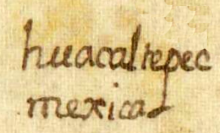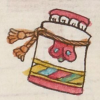Huacaltepec (Azca12)
This compound glyph for the place name Huacaltepec includes various elements. Foremost is a carrying frame (huacalli). This has a wooden frame and net sides. The hill or mountain (tepetl) is surprisingly round, looking something more like a cave. It has rocky outcroppings on the top and sides. Below the huacalli, which is in front of the hill, is a red (leather?) horizontal tie. Below the tie is what may be a piece of cloth or clothing--white with red and white trim at the bottom (perhaps a skirt, cueitl). Finally, a spurt of water (atl) comes out to the right side and downward. The water may play a phonetic role, as there are two a's in the name huacalli.
Stephanie Wood
huacaltepec
mexica
Huacaltepec, Mexica [domain]
Stephanie Wood
post-1550, possibly from the early seventeenth century
Jeff Haskett-Wood
tecnología, cargar, redes, agua, hills, mountain, cerros, montañas, ropa, textiles, faldas, nombres de lugares

huacal(li), carrying frame, https://nahuatl.wired-humanities.org/content/huacalli
tepe(tl), hill, mountain, https://nahuatl.wired-humanities.org/content/tepetl
-tepec, on the hill, https://nahuatl.wired-humanities.org/content/tepec
The Codex Azcatitlan is also known as the Histoire mexicaine, [Manuscrit] Mexicain 59–64. It is housed in the Bibliothèque Nationale de France, and hosted on line by the World Digital Library and the Library of Congress.
https://www.loc.gov/resource/gdcwdl.wdl_15280/?sp=12&st=image
The Library of Congress is “unaware of any copyright or other restrictions in the World Digital Library Collection.” But please cite Bibliothèque Nationale de France and this Visual Lexicon of Aztec Hieroglyphs.






